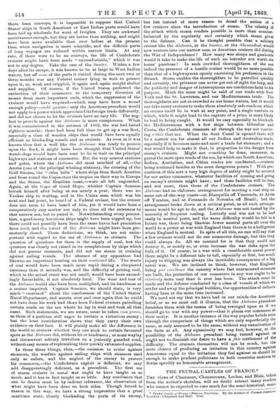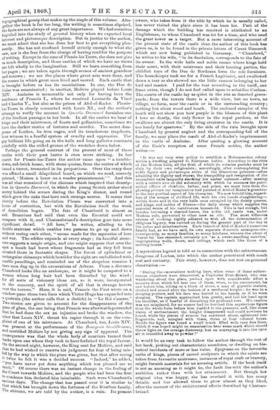THE FEUDAL CASTLES OF FRANCE.* THE views of Chaumont, Chenonceaux,
Loches, and Blois, taken from the author's sketches, will no doubt attract many readers who cannot be expected to care much for the semi-historical, semi topographical gossip that makes up the staple of this volume. Altogether the book is far too long, the writing is sometimes slipshod, the facts are not always of any great importance. We feel ourselves beguiled into the study of general history when we expected local interest and picturesque description. But in justice to the author, we must admit that she has done her best to put everything pleasantly. She has not confined herself strictly enough to what she saw, nor is she free from the charge of having read for the purpose of writing. Except in the case of Plessis-les Tours, she does not give us much description, and those castles of which we have no views are left wholly to the imagination. Still we learn something from her pages ; we are taken again through scenes of ancient grandeur and renown ; we see the places where great acts were done, and the rooms in which great men lived and moved. Each castle that is brought before us has its associations. In one, the Due de Guise was asaaasinated ; in another, Moliere played before Louis XIV. Amboise is memorable not only for having been the residence of Francis I., where he received Leonardo da Vinci and Charles V., but also as the prison of Abd-el-Kader. Plessislea-Tours is closely connected with Louis XI., and the author's attempt to verify the account in Quentin Durward furnishes one of the liveliest passages in her book. In all the castles we hear of kings and their mistresses, of feasts and gallantries, sometimes we have the darker stories of tortures and murder. The secret dungeons of Loches, its iron cages, and its treacherous trapdoors, bear witness to a fearful system of cruelty and oppression. The gay brilliant life going on in the halls and long galleries contrasts painfully with the stifled groans of the wretches down below.
Perhaps the general contrast of the present of most of these castles with their past lustre is even more striking. In her search for Plessis-lea-Tours the author came upon "a tumbledown, red-brick house, with stone quoins, from the centre of which issued a turret, truncated in its proportions. Over the crazy door was affixed a small dilapidated board, on which we read, coarsely painted, liaison a loner on a vendre presentement.' " And this was all that remained of the chateau which inspired that description in Quentin Durward, in which the young Scotch archer stood sentry behind the screen during the King's dinner, and round which grew the oaks that bore such strange acorns. It seems that shortly before the Revolution Plessis was converted into a house of correction, but with the Revolution itself the work of demolition began. The fate of Chambord is almost as sad. Brantame had said that even the Escurial could not compare with it, and Chateanbriand's description goes into more significant detail. ', All here," he writes, alluding to the double staircase which enables two persons to go up and down without seeing each other, "seems made for the mysteries of love and war. The edifice expands at every stage ; its fanciful structure suggests a magic origin, and one might suppose that over the spot a bomb had burst whose fragments had as they fell been arrested there in fantastic shapes. The forest of cylindrical or rectangular chimneys which bewilder the sight are embellished with marble panellings, and reminded me of the shapeless remains I have seen dug up in the excavations of Athens. From a distance Chambord looks like an arabesque, or it might be compared to a woman whose long hair had been disturbed by the wind; for all sorts of visionary ideas are, as it were, incorporated in the masonry, and the spirit of all that is strange hovers over the turrets." Here, it is said, Francis the First wrote on a window-pane those two lines which Victor Hugo has expanded into a quatrain (the author calls that a distich) in "Le Roi s'amuse." Two stories are given to account for the disappearance of the Passe of glass, the one being that Francis was afterwards persuaded that he had done the sex an injustice and broke the window, the Other that Louis XIV. thrust his rapier through it on the complaint of one of his mistresses. At Chambord, too, Louis XIV. was present at the performance of the Bourgeois Gentilhomme, and mortified Moliere by not giving any sign of approval. The consequence was that the whole body of courtiers turned their backs upon one whom they took to have forfeited the royal favour. On the second night, however, the King sent for Moliere, and said that he had wished to reserve his judgment for fear of being misled by the way in which the piece was given, but that after seeing It twice he felt it was a decided success. "Indeed," he added, 'you have never yet done anything which has pleased me so ranch." Of course there was an instant change in the feeling of the Court towards Moliere, and the people who had been the first to condemn him declared him inimitable. Such were Chambord's ancient days. The change that has passed over it is similar to
it which has brought down the fortunes of the Bourbon family. The château, we are told by the author, is a ruin. Its present owner, who takes from it the title by which he is usually called, has never visited the place since it has been his. Part of the damage which the building has received is attributed to an Englishman, to whom Chambord was let for a time, and who used the great tower as a target. But a more interesting account of the present state of the castle than the author of this book has given us, is to be found in the private letters of Count Bismarck which are now being published in Germany. "Chambord," he writes to his wife, "in its desolation, corresponds to the fate of its owner. In the wide halls and noble rooms where kings held their court, with their mistresses and their hunting parties, the childish toys of the Due de Bordeaux form the sole furniture. The housekeeper took me for a French Legitimist, and swallowed down a tear as she showed me the little cannon belonging to her lord and master. I paid for the tear according to the tariff, one franc extra, though I do not feel called upon to subsidize Carliara. The courts of the castle lay as quiet in the sun as deserted graveyards ; from the towers there is a wide view, but no town, no village, no farm, near the castle or in the surrounding country ; nothing but silent wood and heath. The enclosed samples of the heath will not show you how purple is the blossom of this plant I love so dearly, the only flower in the royal gardens, as the swallows are almost the only living creatures in the castle. It is too lonely for sparrows." By the side of the ruin brought upon Chambord by general neglect and the corresponding fall of the family, we may place the result of Abd-el-Kader's imprisonment in the castle of Amboise. After quoting a glowing account of the Emir's reception of some French nobles, the author writes :—
"It was not very wise policy to establish a Mohammedan colony within a dwelling adapted to European habits. According to the rites of the Moslem faith, all the flesh of which its votaries partake must be slain by their own religionists ; accordingly, after contemplating the noble figure and picturesque attire of the illustrious prisoner—after admiring the dignity and repose, the tranquillity and resignation of the recumbent exile languidly smoking his amber calumet—after musing with a certain awe on the solemnity with which he assumes the patriarchal offices of chieftain, father, and priest, we must turn from tho glowing picture our imagination had painted of Abd-el-Kader's grandeur to the less poetical aspect of his character. We now behold him, regardless of the usages of civilized life, with his own hands slaughtering— within doors and in the very halls once occupied by the dainty queens, and kings, and nobles of France—the daily sheep which supplies the material wants of his carnivorous household. This is bad enough, but besides becoming a charnel-house, the noble old castle was, under Moslem rule, perverted to other uses as vile. The most villanons system of cooking, rigidly adhered to with all the determination of religious bigotry, was oarried on during the greater part of the day in the salons and antechambers. Each branch of Abd-el-Kader's numerous family lied, as we have said, its own separate domestic arrangements ; consequently, as many families, so many kitchens, whence the odour of 'burnt fat ' has remained, certainly not 'as a sweet-smelling sacrifice,' impregnating walls, floors, and ceilings, which reek like those of a melting-house."
A mysterious legend is told us in connection with the subterranean dungeons of Loches, into which the author penetrated with much zeal and curiosity. This story, however, does not rest on personal observation :—
Daring the excavations making here, when some of these subterranean chambers were discovered, a Capitaine Pont-Briant, who was wandering about the place, pushed open with considerable effort a massive door, which led into one of them, when, to his amazement, he saw before him, sitting on a block of stone, a LUall of gigantic stature, clothed and armed after the fashion of a mediaaval knight ; he was in a stooping posture, and his face was buried in his hands, as if he were sleeping. The captain approached him gently, and laid his hand upon his shoulder, as if fearful of disturbing his profound rest. His caution was not misplaced, for no sooner had he touched this mysterious figure than the whole form before him yielded to the pressure, and, like some vision of enchantment, the knight disappeared and could nowhere be found, while the pieces of armour lay scattered about, splintered into fragments, and, mingled with them, throe or four colossal bones. Beside the figure was found a small trunk filled with very tine linen, which it was hoped might on examination bear some mark which should throw light on the strange discovery, bat on conveying it into the open air it crumbled away to powder !"
It would be an easy task to follow the author through the rest of her book, picking out characteristic anecdotes, or dwelling on historical incidents of more or less value. Epigrams on the favourite oaths of kings, pieces of sacred sculpture in which the saints are taken from favourite mistresses, instances of royal craft or bravery, might furnish materials for an amusing article. If the book itself is not as amusing as it might be, the fault lies with the author's ambition rather than with her attainment. But though her original idea was happy, she has overlaid it with too many details, and has allowed them to grow almost as they liked, after the manner of the architectural effects described by Chateau briand.































 Previous page
Previous page